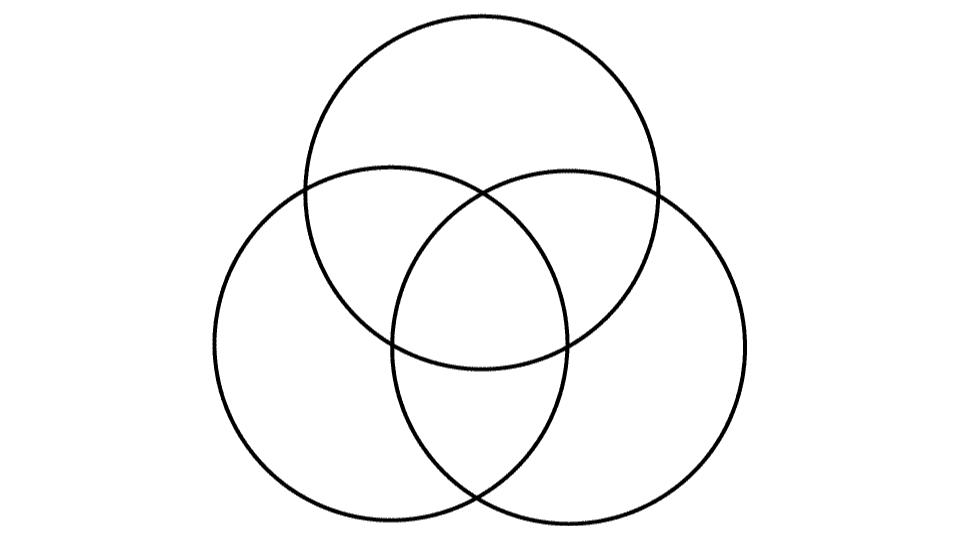Categorical Logic 2.0
We endeavour to employ only symmetrical figures, such as should not only be an aid to reasoning, through the sense of sight, but should also be to some extent elegant in themselves.
~John Venn
From Athens to Great Britain
As discussed in the last lesson, Aristotle's logic was taught in the West basically without opposition (and without any major updates) until the 19th century. Insofar as logic is a method for assessing arguments, categorical logic didn't need much improvement. In fact, some of the updates made to it in the 19th century, as evidenced in the epigraph above, were driven by a desire to make inferences not only valid, but also aesthetically pleasing. That being said, there were some substantive changes on the horizon.1
The updates made to logic were from George Boole, whom we met last time, and John Venn, both of which were British logicians and mathematicians. We'll be looking at these updates in the lessons to come. Today, however, we will move on to mediate inferences, or two-premise arguments of categorical logic. More commonly, these are referred to as categorical syllogisms, as you'll learn in the Important Concepts below. We will begin by standardizing these and then use ancient techniques in assessing them for validity. These methods require us to discover the mood and figure of the syllogisms in question to see if they are valid or not, a method pioneered by Aristotle himself. Then we will move on to the more modern Venn diagrams.
Important Concepts
Mood and Figure
Here are the steps for assessing for validity using mood and figure:
- Put each individual categorical proposition into standard form: quantifier, subject class, copula, and predicate class.
-
Make sure the syllogism as a whole is in standard form. That is,
- the syllogism is composed of three standard-form categorical statements;
- the subject term of the conclusion (the minor term) must occur once and only once in the second premise, and not in the first premise;
- the predicate term of the conclusion (the major term) must occur once and only once in the first premise, and not in the second premise;
- the other term in the first premise (the middle term) must also occur in the second premise.
- Label the argument according to its mood and figure (see Important Concepts above).
- If an argument's mood and figure is on this table, then the argument is valid. If not, then the argument is invalid.
Food for thought...


Circles, circles, circles...2
“Another revolutionary development in nineteenth-century logic was the discovery, by the English logician and philosopher John Venn (1834-1923), of a radically new way to show that a categorical syllogism is valid. Venn’s method allows us to visually represent the information content of categorical sentences, in such a way that we can actually see the relations between the sentences of a syllogism” (Herrick 2013: 176; emphasis added).3
Here are the steps for Venn diagrams that we'll be following:
- Abbreviate.Abbreviate. Abbreviate the argument, replacing each category with a single capital letter.
- Draw and Label. Label the circles (with capital letters) using the minor term (the subject term of the conclusion) for the lower left circle, the major term (the predicate term of the conclusion) for the lower right circle, and the middle term (the remaining class) on the middle circle.
- Decide on Order. If the argument contains a universal premise, enter its information first. If the argument contains two universal premises or two particular premises, order doesn’t matter.
- Enter Premise Information. Universal statements get shaded. Particular statements get an X.
- Note: When placing an X in an area, if one part of the area has been shaded, place the X in an unshaded part. When placing an X in an area, if a circle’s line runs through the area, place the X directly on the line separating the area into two regions. In other words, the X must “straddle” the line, hanging over both sides equally. An X straddling a line means that, for all we know, the individual represented by the X might be on either side of the line, or on both sides; in other words, it is not known which side of the line the X is actually on.
- Remember to decide if you are taking the hypothetical viewpoint. Look at the two circles standing for the subject terms of your premises. If these terms refer to existing things, and if there is only one region unshaded in either or both circles, place an X in that unshaded region (thereby presenting the existential viewpoint). If these terms refer to things that do not exist or the arguer does not wish to assume exist, then you are finished (thereby presenting the hypothetical viewpoint). Repeat for the middle and predicate terms.
- Assess for validity. A categorical syllogism is valid if, by diagramming only the premises, we have also diagrammed the information found in the conclusion. A categorical syllogism is invalid if, when we have diagrammed the information content of the premises, information must be added to the diagram to represent the information content of the conclusion.
- CAUTION: If no X or shading appears in an area, this does not say that nothing exists in the area; rather, it indicates that nothing is known about the area. Again, it only means we have no information about the area. Thus, for all we know, the area might be empty, or it might contain one or more things.
- Label the argument valid or invalid.
- Look over your work.


FYI
Assessing Categorical Arguments for Validity: Venn Diagram Edition
Directions: Use either the mood and figure method or the Venn diagram Method to determine whether the following categorical syllogisms are valid. (Here's the table for mood and figure.)
Note that some arguments may be out of order, placing the conclusion before the premises. Use conclusion indicators, like "therefore" and "so", to help you identify the conclusion. Premise indicators, like "since" will help you identify premises.

- All philosophers are lovers of truth. No lovers of truth are close-minded people. So, no philosophers are close-minded people.
- No dogs are cats, and no fish are dogs. So some cats are fish
- All dogs can sing, and no singers can swim. Therefore, no dogs can swim.
- All anteaters eat hymenoptera. Therefore some Myrmecophagidae are anteaters, since some eaters of hymenoptera are Myrmecophagidae.
- Some scavengers are fish, but some dogs aren’t fish. Therefore, some dogs aren’t scavengers.
- All goats are cute. All small mammals are cute. So, all small mammals are goats.
- Some actors are sculptors. Some poets are not actors. So, some poets are not sculptors.
- All A are B. All A are C. Thus, all C are B.
- Some A are not C, and all C are B. Thus, some A are not B.
- Some B are C. Some B are not A. Therefore, Some A are C.
Tablet Time!

Footnotes
1. I might add that other thinkers of the time were also driven by an appeal to beauty as opposed to experimental data. Physicist James Clerk Maxwell (1831-1879), for example, famous for being the first to hypothesize that a changing electrical charge creates a magnetic field, arrived at this view not through experimental data, but because he was bothered that nature would otherwise be asymmetrical. In other words, for Maxwell, it was a matter of aesthetics that drove him to his conclusion (see Wolfson 2000, Lecture 4).
2. The techniques used here as essentially those of Herrick (2013), chapter 9 in particular. I also, however, am using tips and verbiage found in Monge (2017).
3. I might add that John Venn truly stood on the shoulders of giants with regards to his discovery of another method of assessing for validity. As it turns out, none other than Swiss mathematician Leonhard Euler had offered a series of diagrams also comprised of circles to express the import behind the four sentences of categorical logic. This work was done in the 18th century and was improved upon by the 19th century French mathematician J. D. Gergonne (see Shenefelt and White 2013: 60-64). This, of course, takes nothing away from John Venn's aesthetically pleasing work, which is the culmination of these analyses.

